|
|
|
Sort Order |
|
|
|
Items / Page
|
|
|
|
|
|
|
| Srl | Item |
| 1 |
ID:
101225
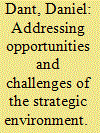

|
|
|
| 2 |
ID:
101224
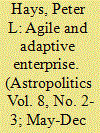

|
|
|
| 3 |
ID:
101223
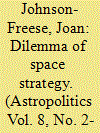

|
|
|
| 4 |
ID:
101229
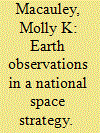

|
|
|
|
|
| Publication |
2010.
|
| Summary/Abstract |
Natural and environmental resources, ranging from supplies of fossil fuels to agricultural productivity, have long been recognized as part of the natural wealth of nations. Earth observations from the vantage point of space provide a unique means of understanding, measuring, and monitoring these resources both domestically and globally. This article argues that design of a national space strategy includes recognition of this role of Earth observations, and accords them priority commensurate with the value of the resources they observe. Recognizing the overlap between a national space strategy and a national security strategy, the article notes examples of the complementarities between Earth observations data from civilian and national security observing systems. The limited public transparency of data from national security sources hinders their usefulness in informing many policy decisions, however. The article also considers whether international cooperation in Earth observations, as in other national space activities, is warranted or workable in a national space strategy.
|
|
|
|
|
|
|
|
|
|
|
|
|
|
|
|
| 5 |
ID:
101222


|
|
|
| 6 |
ID:
101221
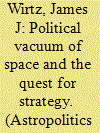

|
|
|
| 7 |
ID:
101228
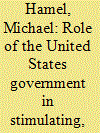

|
|
|
| 8 |
ID:
101220


|
|
|
| 9 |
ID:
101231


|
|
|
|
|
| Publication |
2010.
|
| Summary/Abstract |
Obama Administration officials have indicated that international cooperation will play a greater role in their national space policy than it did during the Bush Administration. But they have not provided a clear and consistent logic specifying why the United States wants more space cooperation, what types of cooperation it will pursue, and how it will convince other countries to agree on, and comply with, accords that produce the desired policy results. Instead, their policy about space cooperation mixes elements from three different and somewhat contradictory strategic logics: a "Global Commons" logic, a "Strategic Stability" logic, and a "Space Governance for Global Security" logic. While each logic has attractive features, the Global Commons logic is unlikely to achieve significant results in a short period of time, while the Strategic Stability logic is more likely to promote competition, rather than cooperation. Following the Space Governance for Global Security logic could yield much larger dividends by using positive and negative forms of space cooperation to gain widespread support for the equitable rules and effective international institutions needed to address the central challenges identified by the 2010 National Security Strategy.
|
|
|
|
|
|
|
|
|
|
|
|
|
|
|
|
| 10 |
ID:
101226
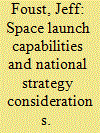

|
|
|
|
|
| Publication |
2010.
|
| Summary/Abstract |
Launching spacecraft into orbit is one of the most challenging and critical aspects of spaceflight, and thus, is a key element of any national space strategy. Over the last several decades, the United States, seeing the high cost of space access as a primary impediment to greater government and commercial utilization of space, has made several attempts to lower the cost of space access, but without success. This analysis challenges whether cost should be the primary criterion for any national space launch strategy. A review of six different civil, commercial, and national security space launch customers shows that for the four major existing customer segments, cost is a lower priority than launch reliability, crew safety, and schedule assurance. Only for two emerging customer segments, Operationally Responsive Space and entrepreneurial space ventures, is cost a primary factor. Given this analysis, existing launch systems actually meet most customers' needs, creating equilibrium in the market. Several events, though, could disrupt that equilibrium in the near future, including the development of new reusable suborbital vehicles and a shift to commercial providers for crew transportation to low Earth orbit.
|
|
|
|
|
|
|
|
|
|
|
|
|
|
|
|
| 11 |
ID:
101230


|
|
|
|
|
| Publication |
2010.
|
| Summary/Abstract |
The threats to space systems posed by hostile states and non-state actors are evolving. Vulnerabilities span the national security, civil, and commercial space communities. The weaknesses have been studied, and adversaries to the United States and its allies have noted the asymmetric advantages space capabilities provide. They see the tremendous leverage that can be obtained by disrupting them. These adversaries are becoming much more diverse, sophisticated, and technologically competent; they are equipped and able to disrupt access to space capabilities. Defending space systems demands new tools as deterring or eliminating these evolving threats will be difficult. Risk posed by an increasingly dangerous space environment must also be addressed. As it has done for decades, the United States enjoys a unique position in which it can shape the direction of global space activities. With this position comes great responsibility-to forge behaviors to mitigate space debris, deter armed conflict, and enhance the peace, security, and prosperity of spacefaring nations and the rest of the world. A space assurance strategy involving deterrence and defense, global engagement, situational awareness, and responsive infrastructure presents the best opportunity to collectively defend, protect, and secure the high frontier.
|
|
|
|
|
|
|
|
|
|
|
|
|
|
|
|
| 12 |
ID:
101219
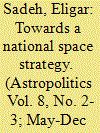

|
|
|
| 13 |
ID:
101227
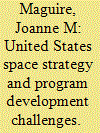

|
|
|
|
|
| Publication |
2010.
|
| Summary/Abstract |
The world has been utterly transformed by space technology and space systems. In the 21st century, we rely on the incredible capabilities they provide us for tasks from the most mundane to the most profound. Every moment of every day, even though we are unaware of its presence, we are engulfed in an invisible digital torrent that streams in two directions, from space to Earth and back again. This ever-present inundation links us to the satellites that serve us, connecting our world in a way that defies imagination. But our nation is not guided by a grand, overarching space strategy. This paper outlines the reason such a strategy is mandatory, the obstacles we must overcome, and the factors we must include in our strategy.
|
|
|
|
|
|
|
|
|
|
|
|
|
|
|
|
|
|
|
|
|